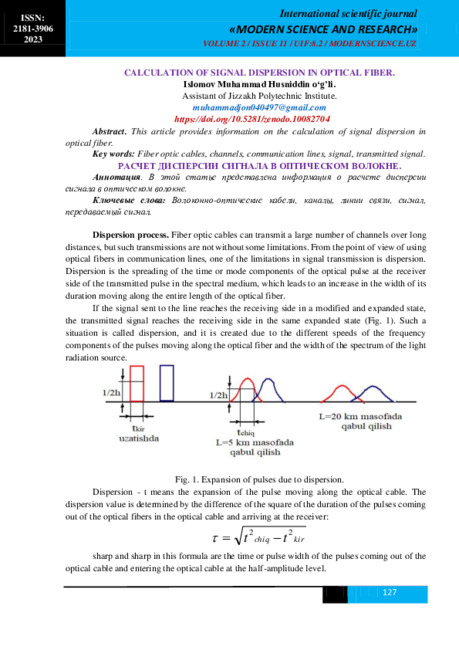
ISSN:
2181-3906
2023
International scientific journal
«MODERN SCIENCE АND RESEARCH»
VOLUME 2 / ISSUE 11 / UIF:8.2 / MODERNSCIENCE.UZ
127
CALCULATION OF SIGNAL DISPERSION IN OPTICAL FIBER.
Islomov Muhammad Husniddin o‘g’li.
Assistant of Jizzakh Polytechnic Institute.
https://doi.org/10.5281/zenodo.10082704
Abstract.
This article provides information on the calculation of signal dispersion in
optical fiber.
Key words:
Fiber optic cables, channels, communication lines, signal, transmitted signal.
РАСЧЕТ ДИСПЕРСИИ СИГНАЛА В ОПТИЧЕСКОМ ВОЛОКНЕ.
Аннотация
. В этой статье представлена информация о расчете дисперсии
сигнала в оптическом волокне.
Ключевые слова:
Волоконно-оптические кабели, каналы, линии связи, сигнал,
передаваемый сигнал.
Dispersion process.
Fiber optic cables can transmit a large number of channels over long
distances, but such transmissions are not without some limitations. From the point of view of using
optical fibers in communication lines, one of the limitations in signal transmission is dispersion.
Dispersion is the spreading of the time or mode components of the optical pulse at the receiver
side of the transmitted pulse in the spectral medium, which leads to an increase in the width of its
duration moving along the entire length of the optical fiber.
If the signal sent to the line reaches the receiving side in a modified and expanded state,
the transmitted signal reaches the receiving side in the same expanded state (Fig. 1). Such a
situation is called dispersion, and it is created due to the different speeds of the frequency
components of the pulses moving along the optical fiber and the width of the spectrum of the light
radiation source.
Fig. 1. Expansion of pulses due to dispersion.
Dispersion - t means the expansion of the pulse moving along the optical cable. The
dispersion value is determined by the difference of the square of the duration of the pulses coming
out of the optical fibers in the optical cable and arriving at the receiver:
kir
chiq
t
t
2
2
sharp and sharp in this formula are the time or pulse width of the pulses coming out of the
optical cable and entering the optical cable at the half-amplitude level.

ISSN:
2181-3906
2023
International scientific journal
«MODERN SCIENCE АND RESEARCH»
VOLUME 2 / ISSUE 11 / UIF:8.2 / MODERNSCIENCE.UZ
128
Dispersion is when a sequence of right-angle pulses in a digital signal travels along a
certain length of optical fiber, the pulses are spread, as a result, two adjacent pulses cannot be
distinguished from each other, and eventually errors occur in the transmission of signals. y gives
Thus, dispersion is one of the main factors limiting the bandwidth or bandwidth of a fiber optic
transmission system and the communication distance.
Types of dispersion.
Optical fiber has three dispersion mechanisms:
- intermodal dispersion;
- chromatic dispersion;
- polarized – mode dispersion.
Chromatic dispersion consists of material dispersion, dispersion related to wave
transmission and profile dispersion.
Dispersion compensation methods. According to statistics, the most laid cables consist of
single-mode standard SF (Standard Fiber) fibers. Currently, the attenuation values of SF fibers
have been reduced to 0.16-0.22 dB/km. However, the dispersion value of these fibers at a
wavelength of 1550 nm is 17-20 ns/nm·km. Such a large value of dispersion limits the transmission
of information at high speeds (above 10 Gbit/s) over long distances.
When single-mode standard SF fibers are used, the dispersion value should be reduced. In
order to reduce the dispersion when using standard single-mode optical fibers in the fiber optic
line tract, increase the length of the regeneration section, move from 2.5 Gbit/s speed to 10 Gbit/s
speed, as well as apply the technology of wavelength densification. DCF (Dispersion
Compensating Fiber) fibers or DCM (Dispersion Compensating Module) dispersion compensating
modules are required.
DCF is a dispersion compensating fiber used mainly to reduce chromatic dispersion. In
DCF fibers, the dispersion value is negative and has large values. As a result of connecting DCF
fibers with a negative dispersion to a working fiber with a positive dispersion, the dispersion
approaches zero, that is, it is compensated.
Dispersion compensation unit (DCU - dispersion compensation unit) DCU compensates
for the dispersion of the transmission fiber We use a negative dispersion DCU to compensate for
pulses that are "spread" (broadened) by the movement of the dispersion state in the transmission
fiber (Fig. 2).
Figure 2. Dispersion Compensation Unit (DCU)
In the transmission fiber, the negative moving dispersion ("blue" light with a shorter
wavelength propagates more slowly than the "red") is neutralized by the positive moving
dispersion, that is, the lower and higher components of the frequency spectrum are transmitted at
the same speed provides. We use DCU on a length of fiber where chromatic dispersion is of great
importance, because DCU allows to significantly reduce the dispersion compared to the
transmission fiber.

ISSN:
2181-3906
2023
International scientific journal
«MODERN SCIENCE АND RESEARCH»
VOLUME 2 / ISSUE 11 / UIF:8.2 / MODERNSCIENCE.UZ
129
REFERENCES
1.
Yunusov N.Yu., Isayev R.I., Mirazimova G.X. Optik aloqa asoslari. O‘zbekiston
Respublikasi Oliy va o‘rta maxsus ta’lim vazirligi – T.: Cho‘lpon nomidagi NMIU, 2014
– y. – 368 bet.
2.
Mirazimova G.X. Optik aloqa asoslari: O‘quv qo‘llanma., t.f.n., dosent Isaev R.I. mas’ul
muharrirligi ostida.-Toshkent, TATU bosmaxonasi, 2006.- 136 b.
3.
Иванов В.И., Гордиенко В.Н., Попов Г.Н., Исаев Р.И. и др. Цифровые и аналоговые
системы передачи: Учебник для вузов/ Под ред. Иванова В.И.- 2-е изд. – М.: Горячая
линия – Телеком, 2003.
4.
Islomov, M., & Irisboyev, F. (2023). IOT (INTERNET OF THINGS) TECHNOLOGIES
OF INTERNET DEVICES.
Modern Science and Research
,
2
(9), 220-223.
5.
Irisboyev, F. (2022). ELEKTR SIGNALLAR KUCHAYTIRGICHLARI VA
ULARNING ASOSIY PARAMETRLARI VA TAVSIFLARI.
Евразийский журнал
академических исследований
,
2
(11), 190-193.
6.
Ирисбоев, Ф. Б., Эшонкулов, А. А. У., & Исломов, М. Х. У. (2022). ПОКАЗАТЕЛИ
МНОГОКАСКАДНЫХ УСИЛИТЕЛЕЙ.
Universum: технические науки
, (11-3
(104)), 5-8.
7.
Irisboyev, F. (2022). YARIMO ‘TKAZGICHLI MODDALARDAN
TAYYORLANADIGAN KUCHAYTIRGICHLARNING PARAMETRLARI VA
XARAKTERISTIKALARI.
Science and innovation
,
1
(A6), 374-377.
8.
Irisboyev, F. B. (2022). ELEKTRON ZANJIRLAR VA MIKROSXEMOTEXNIKA
QURILMALARINING ASOSLARI.
Academic research in educational sciences
,
3
(10),
15-19.





